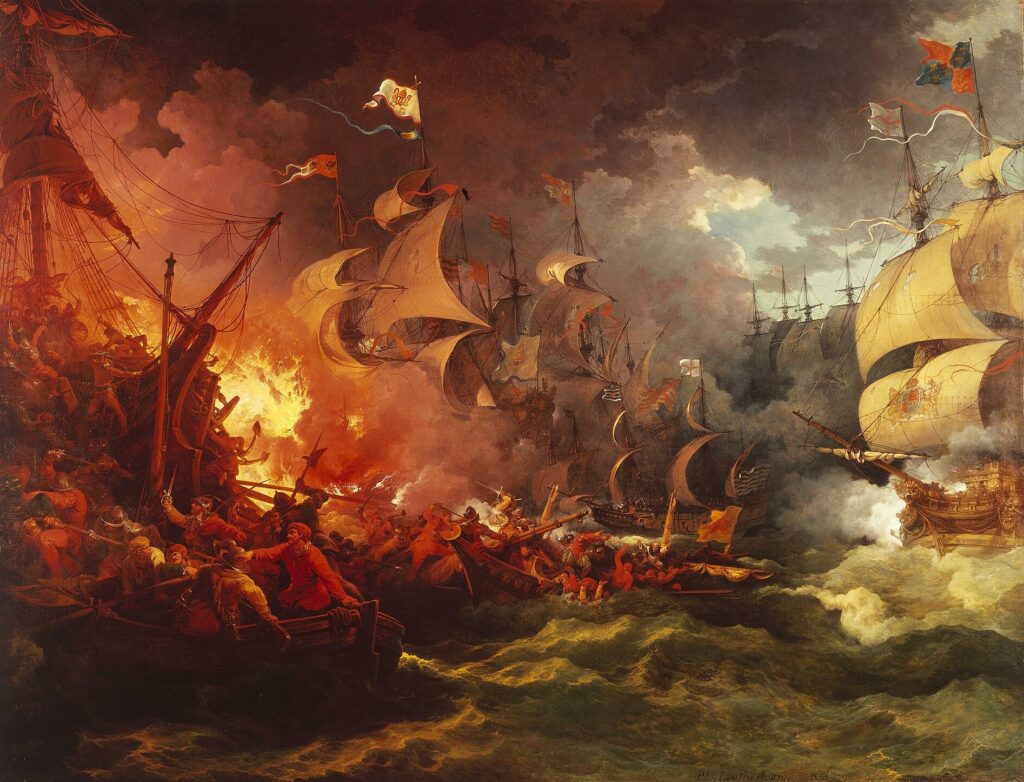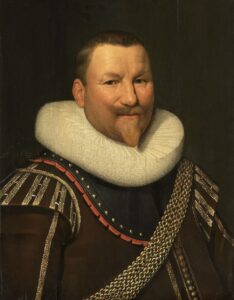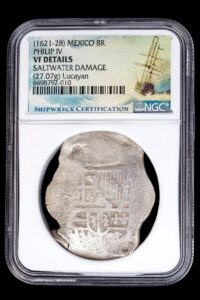
1621-1628 Mexico 8 Reales NGC VF Details – Lucayan Beach Treasure!
Item #CC-0457 | 1621-1628 Mexico 8 Reales NGC VF Details – Lucayan Beach Treasure!
Mint: Mexico City
Assayer: Not Visible
Ruler/Period: King Philip IV
Grade: VF Details
For details and population on this coin from NGC, click on the serial number here: 6698792-010
Description: This is a rare Spanish Colonial “Piece of Eight” that was recovered from a shipwreck!
In the summer of 1964, divers working off Lucayan Beach, Grand Bahama Island, found an unusual anchor on the seabed. This anchor lacked the usual cross arms which indicated that it came from an early vessel. The next day, the divers located two cannons, ballast stones and silver coins. The boat had grounded, it appeared, in ten feet of water between two reefs only half a mile from the shore. The bottom of the boat had been ripped away, spilling the coins and ballast over a large area of seabed.
The somewhat primitive diving methods at the time had been sufficient to recover much of the wreckage but the coins, which were light enough to be dispersed by the currents, lay undetected for over three hundred years. By the time they were discovered, recovery was easy. The coins were brought to the surface in conglomerate form, bonded together by the coral growths, and later cleaned and sorted.
One of the most exciting aspects of this treasure is its origin. Although we cannot prove anything with absolute certainty, there are certain historical facts which, put together, do more than just hint at a remarkable story.
 Many of the recovered coins from this wreck bear the date 1628 (proving the wreck could not have occurred earlier) which was also the occasion of a remarkable piece of piracy. Each year in the late summer, before the start of hurricane season, the Spanish treasure fleets would gather at the port of Havana and then, loaded with silver from the New World, would sail “the Golden Road” back to Spain. However, in the Summer of 1628 an event took place that not only changed the course of history, but would also go down as one of the greatest naval victories of the 17th century.
Many of the recovered coins from this wreck bear the date 1628 (proving the wreck could not have occurred earlier) which was also the occasion of a remarkable piece of piracy. Each year in the late summer, before the start of hurricane season, the Spanish treasure fleets would gather at the port of Havana and then, loaded with silver from the New World, would sail “the Golden Road” back to Spain. However, in the Summer of 1628 an event took place that not only changed the course of history, but would also go down as one of the greatest naval victories of the 17th century.
The Battle of the Bay of Matanzas
In May of 1628 the Dutch West India Company had amassed a powerful naval fleet consisting of more than fifty warships with the objective of capturing the Spanish treasure fleet in the Caribbean. The Dutch knew that the Spanish treasure fleet made annual voyages from the New World colonies to Spain and were laden with tons of gold, silver, gems, and other valuables. This daring mission would serve two purposes, one would be to eliminate Spain’s ability to pay their armed forces in Europe, and the second would be to supply the Dutch with much needed revenue to support their war for control of the Spanish held Netherlands (now Belgium and Luxembourg).
 The man appointed to lead this daring mission was Piet Pietersen Heyn.
The man appointed to lead this daring mission was Piet Pietersen Heyn.
Piet Heyn (Nov. 15, 1577 – June 18, 1629) was an admiral and director of the Dutch West India Company who was a highly experienced sailor. He was also fluent in Spanish as a result of being captured at sea in 1597, where he spent four years as a Spanish galley rower.
Once the Dutch fleet arrived in the West Indies, provisions had run low and Heyn sent part of his fleet to the island of Blanquilla for supplies. The island was uninhabited but had a large feral goat and donkey population, as well as other resources the sailors needed. Once re-supplied, the Dutch ships departed but accidentally left a cabin boy behind. This young lad was later captured by the Spanish and ultimately revealed Heyn’s plan.
Made aware of the ambush being set, the Spanish kept part of their treasure ships in port at Cartagena and Veracruz and waited for Heyn and his fleet to leave. However, the other half of the treasure fleet from Mexico continued its voyage to Cuba, unaware of the threat.
Meanwhile Heyn patiently patrolled the waters North of Havana waiting for his Spanish prey to arrive.
Towards the beginning of September, supplies were becoming critically low again and scurvy was starting to break out among the Dutch sailors. Knowing that many of his sailors were no longer fit to fight and the threat of hurricanes looming on the horizon, Heyn decided to send the worst cases home with part of his fleet, while he remained with the rest. The departure of these ships unwittingly served as a decoy that was reported to the Spanish, who assumed that the coast was clear. Thinking that the Dutch had left, the order was given for the treasure fleet at Cartagena and Veracruz to sail.
On September 8, 1628, Heyn, ambushed the Spanish fleet and captured sixteen Spanish ships: one galleon was taken after a surprise encounter during the night, nine smaller merchantmen were talked into surrendering; two small ships were overtaken at sea, and four fleeing galleons were trapped on the Cuban coast in the Bay of Matanzas. One by one the Spanish ships were overtaken and compelled to surrender by the Dutch, with only four ships making it to the bay, but this did them little good. Heyn’s ships followed them in and captured these vessels too.
The 1628 Spanish treasure fleet was commanded by Juan de Benavides, a corrupt official with no experience of seamanship or naval warfare. His ships were ill-prepared for battle, and were said to be so overloaded with cargo and passengers that his sailors were unable to operate their guns. Even if Benavides had been able or willing to fight, his sixteen ships were heavily outnumbered by the thirty-one warships still available to the Dutch.
The Dutch had succeeded in inflicting one of the worst disasters ever to befall the Spanish Empire. The sixteen ships captured represented a third of the Spanish ships operating in the Caribbean at the time.
Altogether, Heyn captured 11,509,524 guilders (half a billion Euros in today’s money; £1 million using sterling/guilder exchange rates in the 1620s) of booty in gold, silver, and expensive trade goods, such as indigo and cochineal without any bloodshed.
 Piet Hein returned home as a national hero, whereas the Spanish Captain General was executed and the Spanish fleet Admiral was banished to North Africa.
Piet Hein returned home as a national hero, whereas the Spanish Captain General was executed and the Spanish fleet Admiral was banished to North Africa.
Heyn had planned to retire with his share of the booty but was recalled to active duty with the rank of lieutenant admiral of Holland in 1629. He was then given command of the republic’s entire fleet and ordered to clear the North Sea of the Dunkirk pirates, who were in the pay of King Philip IV of Spain. Although Heyn’s fleet destroyed the pirates in June of 1629, he was killed in the battle.
For more information on Piet Heyn, visit https://www.britannica.com/biography/Piet-Heyn
For more information on the Battle of Matanzas Bay, visit: https://en.wikipedia.org/wiki/Battle_in_the_Bay_of_Matanzas
In stock
$1,700.00

